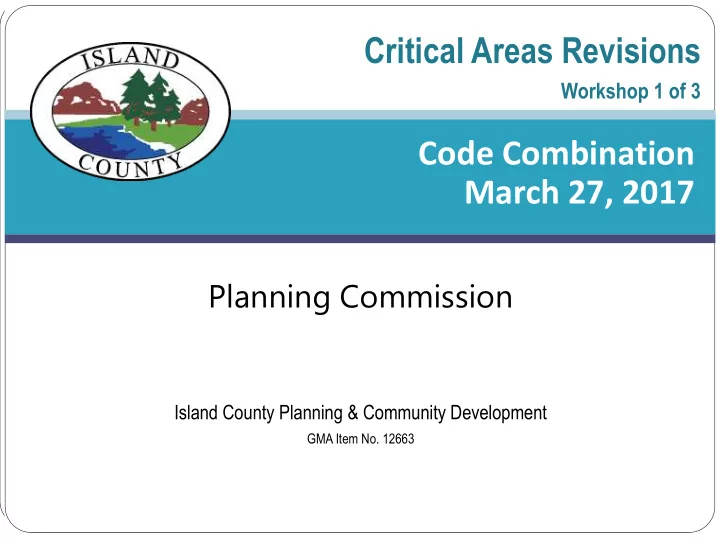

Critical Areas Revisions – Code Combination Critical Areas Revisions Workshop 1 of 3 Code Combination March 27, 2017 Planning Commission Island County Planning & Community Development GMA Item No. 12663
Critical Areas Revisions – Code Combination Three CAO Code Chapters – How we got here ICC 17.02 Created First – Addresses All Critical Areas ICC 17.02A Created Second – Updated Wetlands Regulations ICC 17.02B Created Last – Updated Fish and Wildlife Habitat Conservation Areas Regulations As new chapters were adopted, old chapters not repealed because some information still relevant Created duplicate and sometimes contradicting definitions and regulations
Critical Areas Revisions – Code Combination Goals of this Combination Process Create one critical areas chapter that applies to all critical areas Remove duplications and contradictions Update definitions to be more consistent with relevant WACs and RCWs Update references to current technical guidance materials
Critical Areas Revisions – Code Combination Basic Structure of CAO A. Basic Introductory/Establishment Items 1. Purpose and Intent 2. Authority 3. Applicability 4. Relationship to Other Regulations 5. Definitions B. Permit Process 1. Permit Required 2. General Mitigation requirements 3. Designation, Classification and Mapping 4. Exempt Activities 5. Permitted Alterations 6. Variances 7. Evaluation and Protection Standards C. Monitoring and Adaptive Management 1. Surface Water Quality 2. Wetlands
Critical Areas Revisions – Code Combination Matrices – Types of Changes Replaced with more recently adopted content Moved Moved and then changed Deleted New Changed * Codes utilized in the matrices are utilized to help draw attention to where and what types of changes are proposed and to provide a guide to related tracked changes. A full review of the document is recommended for a more comprehensive understanding. In upcoming slides staff will review noteworthy changes.
Critical Areas Revisions – Code Combination Changes to Note Island County Code Change Section 17.02B.010C,E&F New purpose and intent statements related to wetlands, CARAs and Frequently Flooded Areas 17.02B.030 Applicability rewritten to apply to all critical areas 17.02B.080L(5) Mitigation Approval Criteria – added general mitigation plan requirements recommended in Commerce handbook 17.02B.320G Added provision under variances section to ensure that public works reviews and approves all development proposals within geologically hazardous areas 17.02B.400C General standards for critical areas documentation clarified 17.02B.460E(3) 17.02B allows but does not require mitigation monitoring, added a separate requirement in wetland section requiring monitoring consistent with current practice 17.02B.310C Wetland single family permitted alterations section modified to be consistent with FWHCA single family permitted alterations section [17.02B.310B(6)]. No change in effect - necessary for consistency and to utilize adopted definitions
Critical Areas Revisions – Code Combination Passive Activities Exemption Code Section Language Exemption Table 17.02B.300 #15 Passive activities. Provided no gasoline powered, motorized boats or equipment are used, conservation, recreation, education and scientific research activities within critical areas and critical area buffers including fishing, hunting, hiking and bird watching. Installation of fences to protect habitat and trails in buffers is allowed provided best management practices adopted by the County are implemented Exemption for passive activities provided for wetlands through 17.02A.060H, that • exemption now extended to FWHCAs
Critical Areas Revisions – Code Combination Public Trans. & Utility Permitted Alterations • Revised wetlands public utilities and transportation permitted alterations to be more consistent with commerce guidance
Critical Areas Revisions – Code Combination Base Density Provision Code Section Language 17.02A.050E Base density exception. Critical area buffers may be reduced by the county hearing examiner when a property owner of a ten-acre or larger existing lot is unable to achieve the base density allowed under chapter 17.03 due to the requirements of this chapter. Buffer modification requests under this subsection shall be reviewed under the review procedures set forth for Type III decisions in chapter 16.19. Such buffer modifications may be permitted when: 1. The owner demonstrates that the lot averaging provisions of chapter 17.03, the use of a planned residential development under chapter 16.17 and the provisions of this chapter do not allow the owner to achieve base density; 2. The owner demonstrates that modification of critical area buffer requirements is the only practical and reasonable option to achieve the base density; 3. The alteration has been reduced as required by section 17.02A.040.A.5.; and 4. If the alteration cannot be restored as required by section 17.02A.040.A.5., the development proposal includes mitigation required by this chapter. Base density process not included in 17.02B, therefore is proposed for deletion. Existing language in 17.02B governs the creation of lots wholly constrained by critical areas, this language is supplemented by the PRD process, density bonus provisions of 17.03, and to some extent, the lot size averaging provisions of 17.03, all which achieve a similar result
Critical Areas Revisions – Code Combination Voluntary Improvement Projects Code Section Language 17.02B.310C(3) 3. Voluntary conservation, preservation, or enhancement projects. The Planning Director shall require a biological site assessment per the provisions of this chapter in order to determine whether the proposed development would conserve, preserve, or enhance critical area functions in the long-term and is designed to minimize temporary environmental impacts. Deleted provisions in 17.02A.050D and replaced with new language to be • consistent with FWHCAs since it has more general applicability
Critical Areas Revisions – Code Combination Next Steps Please continue to provide comments and feedback as you review the documents Next meeting will discuss: Changes to the Surface Water Monitoring Program Periodic Review Recommended Updates
Recommend
More recommend